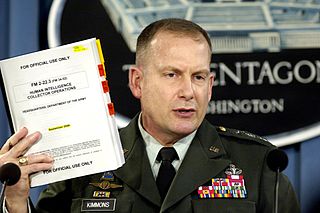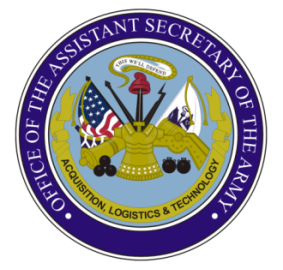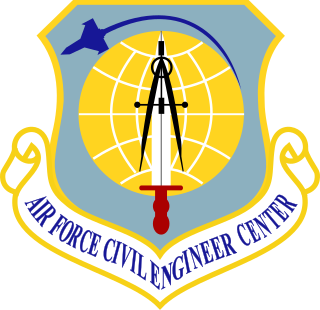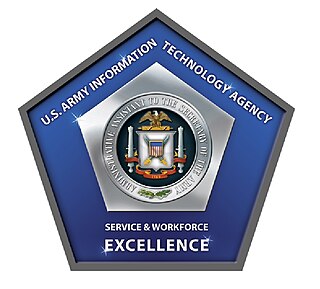Military doctrine is the expression of how military forces contribute to campaigns, major operations, battles, and engagements.

The United States Department of the Army (DA) is one of the three military departments within the Department of Defense of the U.S. The Department of the Army is the federal government agency within which the United States Army (U.S.) is organized, and it is led by the secretary of the Army, who has statutory authority under 10 United States Code § 7013 to conduct its affairs and to prescribe regulations for its government, subject to the limits of the law, and the directions of the secretary of defense and the president.

The Tri-Service aircraft designation system is a unified system introduced in 1962 by the United States Department of Defense for designating all U.S. military aircraft. Previously, the U.S. armed services used separate nomenclature systems.

Joint Regulation 4120.15E: Designating and Naming Military Aerospace Vehicles is the current system for designating all aircraft, helicopters, rockets, missiles, spacecraft, and other aerial vehicles in military use by the United States Armed Forces.
NATO Joint Military Symbology is the NATO standard for military map symbols. Originally published in 1986 as Allied Procedural Publication 6 (APP-6), NATO Military Symbols for Land Based Systems, the standard has evolved over the years and is currently in its fifth version (APP-6D). The symbols are designed to enhance NATO's joint interoperability by providing a standard set of common symbols. APP-6 constituted a single system of joint military symbology for land, air, space and sea-based formations and units, which can be displayed for either automated map display systems or for manual map marking. It covers all of the joint services and can be used by them.

United States Army Field Manuals are published by the United States Army's Army Publishing Directorate. They contain detailed information and how-tos for procedures important to soldiers serving in the field.
Mission command, also referred to as mission-type tactics, is a style of military command, which is derived from the Prussian-pioneered mission-type tactics doctrine, combines centralized intent with decentralized execution subsidiarity, and promotes freedom and speed of action, and initiative within defined constraints. Subordinates, understanding the commander's intentions, their own missions, and the context of those missions, are told what effect they are to achieve and the reason that it needs to be achieved. Subordinates then decide within their delegated freedom of action how best to achieve their missions. Orders focus on providing intent, control measures, and objectives and allow for greater freedom of action by subordinate commanders. Mission command is closely related to civilian management concept of workplace empowerment, and its use in business has been explored by writers such as Bungay (2011) and Tozer. It is advocated but not always used by the militaries of the United States, Canada, Netherlands, Australia and the United Kingdom. Mission command is compatible with modern military net-centric concepts, and less centralized approaches to command and control (C2) in general.

The U.S. Army Combined Arms Center (USACAC) is located at Fort Leavenworth and provides leadership and supervision for leader development and professional military and civilian education; institutional and collective training; functional training; training support; battle command; doctrine; lessons learned and specified areas the Commanding General, United States Army Training and Doctrine Command (TRADOC) designates in order to serve as a catalyst for change and to support developing relevant and ready expeditionary land formations with campaign qualities in support of the joint force commander.

Military organization or military organisation is the structuring of the armed forces of a state so as to offer such military capability as a national defense policy may require. In some countries paramilitary forces are included in a nation's armed forces, though not considered military. Armed forces that are not a part of military or paramilitary organizations, such as insurgent forces, often mimic military organizations, or use these structures, while formal military organization tends to use hierarchical forms.
In 1963, the U.S. Department of Defense established a designation system for rockets and guided missiles jointly used by all the United States armed services. It superseded the separate designation systems the Air Force and Navy had for designating US guided missiles and drones, but also a short-lived interim USAF system for guided missiles and rockets.

The United States Army Security Assistance Command (USASAC) – the 'Army's Face to the World' - implements security assistance programs, including Foreign Military Sales (FMS) of defense articles and services to eligible foreign governments. In addition, USASAC is responsible for the US Army's security assistance information management and financial policy and provides logistics guidance to the army's security assistance community. The command also supports the U.S. government's emergency assistance, humanitarian relief, and Operations Other Than War, including peacekeeping operations by the United Nations. The USASAC traces its origins to the Army's technical service era, and was designated a major subordinate command (MSC) of the U.S. Army Materiel Command (AMC) in 1975. Since its formation, USASAC has supported major US military operations and supported international peacekeeping and humanitarian efforts. The USASAC's motto is "Strength in Cooperation."

The United States Army Installation Management Command (IMCOM) is a support formation of the United States Army responsible for the day-to-day management of Army installations around the globe. Army garrisons are communities that provide many of the same types of services expected from any small city. IMCOM is a major subordinate command of U.S. Army Materiel Command (AMC). IMCOM is headquartered at Fort Sam Houston.

The Office of the United States Assistant Secretary of the Army for Acquisition, Logistics, and Technology (ASA(ALT) pronounced A-salt) is known as OASA(ALT). OASA(ALT) serves, when delegated, as the Army Acquisition Executive, the Senior Procurement Executive, the Science Advisor to the Secretary of the Army, and as the senior research and development official for the Department of the Army. The OASA(ALT) also has the principal responsibility for all Department of the Army matters related to logistics.

The United States Army Air Forces was the major land-based aerial warfare service component of the United States Army and de facto aerial warfare service branch of the United States during and immediately after World War II (1941–1945). It was created on 20 June 1941 as successor to the previous United States Army Air Corps and is the direct predecessor of the United States Air Force, today one of the six armed forces of the United States. The AAF was a component of the United States Army, which on 2 March 1942 was divided functionally by executive order into three autonomous forces: the Army Ground Forces, the United States Army Services of Supply, and the Army Air Forces. Each of these forces had a commanding general who reported directly to the Army Chief of Staff.

The Adjutant General School and the Soldier Support Institute (SSI) are located at Fort Jackson, South Carolina. The school was formerly located at Fort Benjamin Harrison, Indiana, until its closure. These provide training and development of doctrine and organization for Army personnel and administrative operations. Along with the U.S. Army Forces Command (FORSCOM), United States Army Training and Doctrine Command (TRADOC) was created from the Continental Army Command (CONARC) located at Fort Monroe, VA on 1 July 1973. Today, TRADOC is the overseer of training of the Army forces, the development of operational doctrine, and the development and procurement of new weapons systems. The reconstructed Adjutant General Corp Regiment (AG) was created in 1987. The U.S. Army administration and finance specialists are trained at the Adjutant General School located at Fort Jackson. Today's AG Corps serves as human resource (HR) managers for the Army.

To reinforce the Army profession and its Ethic, the Army Chief of Staff (CSA) established the Army Center of Excellence for the Professional Military Ethic (ACPME) in May 2008. Located at West Point, New York, the wellspring of professional soldier values for more than 200 years, the ACPME was re-designated as the Center for the Army Profession and Ethic (CAPE) and realigned to fall under the command and control of the United States Army Training and Doctrine Command (TRADOC) and its Combined Arms Center (CAC) in August 2010. CAPE's objectives were to assess the state of Army as a profession and its members as professionals; to study and define through doctrine and strategic messaging the Army Profession; capture and promulgate the moral principles of the Army Ethic, Army culture, and organizational climates; inspire trusted Army professionals to live up to their sacred oaths, increase Army members’ understanding and internalization of what it means for Soldiers and Army Civilians to be members of an honored profession; accelerate professional and character development in individuals, units, and Army culture through training, education, and leader development. AR 600-100 Army Profession and Leadership specified 12 tasks for CAPE to serve the Army in leader development, critical thinking and ethical decision making based upon the moral principles of the Army Ethic. Army Doctrine Publication (ADP) 1 and Army Doctrine Reference Publication (ADRP) 1. CAPE, as the AR 5-22 Army Force Modernization Proponent for the Army Profession, Character Development, and the Army Ethic was the US Army and lead responsible for Doctrine, Organization, Training, Materiel, Leadership and Education, Personnel and Facilities (DOTMLPF) initiatives to reinforce the Army Profession of Arms, Army Ethic, and culture. In September 2019, CAPE was merged with the Center for Army Leadership at Fort Leavenworth, KS to form the Center for the Army Profession and Leadership.

The Air Force Civil Engineer Center (AFCEC), located at Joint Base San Antonio-Lackland, Texas, is a 1,900-person primary subordinate unit, assigned to the Air Force Installation and Mission Support Center which is one of six centers aligned under Air Force Materiel Command for the United States Air Force. The center is responsible for providing responsive, flexible full-spectrum installation engineering services. Conducting operations at more than 75 locations worldwide, the center's missions include facility investment planning, design and construction, operations support, real property management, energy support, environmental compliance and restoration, and audit assertions, acquisition and program management.

The United States Army Information Technology Agency (ITA) is one of the administrative service organizations aligned under the Office of the Administrative Assistant to the Secretary of the Army (OAA). OAA has three fundamental functions. The primary mission of the organization is to provide direct support to the Secretary of the Army and other Army political appointees. The second mission is to provide administrative support to the Headquarters, Department of the Army (HQDA). The third mission is to provide base operations support to a diverse group of Army and Department of Defense (DoD) customers. OAA is organized into four major divisions: the U.S. Army Resources and Programs Agency (RPA), the U.S. Army Headquarters Services (AHS), the U.S. Army Information Technology Agency (ITA), and the U.S. Army Center of Military History (CMH). These divisions support OAA primarily in areas of IT, logistics, training, and human resources support.
The Army Regulation (AR) 25-50 Preparing and Managing Correspondence is the United States Army's administrative regulation that "establishes three forms of correspondence authorized for use within the Army: a letter, a memorandum, and a message."













